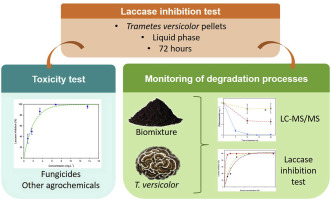Ecotoxicology and Environmental Safety ( IF 6.2 ) Pub Date : 2020-03-14 , DOI: 10.1016/j.ecoenv.2020.110419 Melissa Chan-Cheng 1 , Juan Carlos Cambronero-Heinrichs 2 , Mario Masís-Mora 1 , Carlos E Rodríguez-Rodríguez 1

|
Ecotoxicological evaluations require the use of assays with several bioindicators from different trophic levels. Only a few ecotoxicological tests using fungi have been developed, reason why, detection of adverse effects from compounds that exert fungicide action may be overlooked. This work developed a toxicity test based on the inhibition of laccase enzymatic activity in the fungus Trametes versicolor. The test was applied to several fungicides and succeeded to determine inhibition values (half maximum effective concentration, EC50) for most of them (flusilazole, imazalil, pyrimethanil, tetraconazole), though a clear dose-response was not evident for others (thiabendazole, metalaxyl). The application on atrazine (herbicide), imidacloprid (insecticide) and oxytetracycline (antibiotic), proved the proposed test is suitable towards other agrochemicals. The test was also used to estimate the detoxification resulting from two different approaches employed in the removal of agrochemicals. (a) First, in the liquid-phase elimination by fungal biomass simultaneously removing atrazine, imazalil, tebuconazole and triadimenol, the test showed a significant decrease in toxicity by biodegradation (adsorption contribution to detoxification was negligible). (b) Second, a solid-phase biomixture (used for pesticide degradation from agricultural wastewater) partially removed atrazine, imazalil, metalaxyl and pyrimethanil after 33 d; nonetheless, this system could not reduce the toxicity of the matrix, and higher laccase inhibition was detected after the treatment. The design test increases the battery of available bioassays to determine the toxicity of agrochemicals, and provides an interesting tool to monitor biodegradation processes.
中文翻译:

基于抑制真菌漆酶活性的生态毒理学测试:在农用化学品中的应用以及对农药降解过程的监测。
生态毒理学评估要求使用具有不同营养水平的几种生物指标进行测定。仅开发了几种使用真菌的生态毒理学试验,为什么忽略了从发挥杀菌作用的化合物中产生的不良反应的原因。这项工作开发了一种毒性测试,该测试基于对漆树Trametes versicolor的漆酶酶活性的抑制作用。该测试已应用于多种杀菌剂,并成功确定了抑制值(最大有效浓度一半,EC 50),但对于大多数药物(噻菌灵,甲霜灵)却没有明显的剂量反应。在阿特拉津(除草剂),吡虫啉(杀虫剂)和土霉素(抗生素)上的应用证明,该测试方法适用于其他农药。该测试还用于估算由两种不同的农药去除方法引起的排毒。(a)首先,在通过真菌生物质同时去除阿特拉津,咪唑,戊唑醇和三苯二酚的液相消除中,该试验表明生物降解的毒性显着降低(对解毒的吸附作用可忽略不计)。(b)其次,固相生物混合物(用于从农业废水中降解农药)部分去除了阿特拉津,33 d后咪唑,甲霜灵和嘧霉胺;然而,该系统不能降低基质的毒性,并且在处理后检测到更高的漆酶抑制作用。设计测试增加了可用的生物测定方法来确定农用化学品的毒性,并提供了一个有趣的工具来监控生物降解过程。











































 京公网安备 11010802027423号
京公网安备 11010802027423号